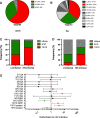Increases in CSF dopamine in HIV patients are due to the dopamine transporter 10/10-repeat allele which is more frequent in HIV-infected individuals
- PMID: 24057505
- PMCID: PMC3779317
- DOI: 10.1007/s00702-013-1086-x
Increases in CSF dopamine in HIV patients are due to the dopamine transporter 10/10-repeat allele which is more frequent in HIV-infected individuals
Abstract
Dysfunction of dopaminergic neurotransmission has been implicated in HIV infection. We showed previously increased dopamine (DA) levels in CSF of therapy-naïve HIV patients and an inverse correlation between CSF DA and CD4 counts in the periphery, suggesting adverse effects of high levels of DA on HIV infection. In the current study including a total of 167 HIV-positive and negative donors from Germany and South Africa (SA), we investigated the mechanistic background for the increase of CSF DA in HIV individuals. Interestingly, we found that the DAT 10/10-repeat allele is present more frequently within HIV individuals than in uninfected subjects. Logistic regression analysis adjusted for gender and ethnicity showed an odds ratio for HIV infection in DAT 10/10 allele carriers of 3.93 (95% CI 1.72-8.96; p = 0.001, Fishers exact test). 42.6% HIV-infected patients harbored the DAT 10/10 allele compared to only 10.5% uninfected DAT 10/10 carriers in SA (odds ratio 6.31), whereas 68.1 versus 40.9%, respectively, in Germany (odds ratio 3.08). Subjects homozygous for the 10-repeat allele had higher amounts of CSF DA and reduced DAT mRNA expression but similar disease severity compared with those carrying other DAT genotypes. These intriguing and novel findings show the mutual interaction between DA and HIV, suggesting caution in the interpretation of CNS DA alterations in HIV infection solely as a secondary phenomenon to the virus and open the door for larger studies investigating consequences of the DAT functional polymorphism on HIV epidemiology and progression of disease.
Figures



References
-
- Cornish KM, Manly T, Savage R, Swanson J, Morisano D, Butler N, Grant C, Cross G, Bentley L, Hollis CP. Association of the dopamine transporter (DAT1) 10/10-repeat genotype with ADHD symptoms and response inhibition in a general population sample. Mol Psychiatry. 2005;10:686–698. doi: 10.1038/sj.mp.4001641. - DOI - PubMed
-
- Czub S, Koutsilieri E, Sopper S, Czub M, Stahl-Hennig C, Muller JG, Pedersen V, Gsell W, Heeney JL, Gerlach M, Gosztonyi G, Riederer P, ter Meulen V. Enhancement of central nervous system pathology in early simian immunodeficiency virus infection by dopaminergic drugs. Acta Neuropathol. 2001;101:85–91. - PubMed
Publication types
MeSH terms
Substances
LinkOut - more resources
Full Text Sources
Other Literature Sources
Medical
Research Materials

